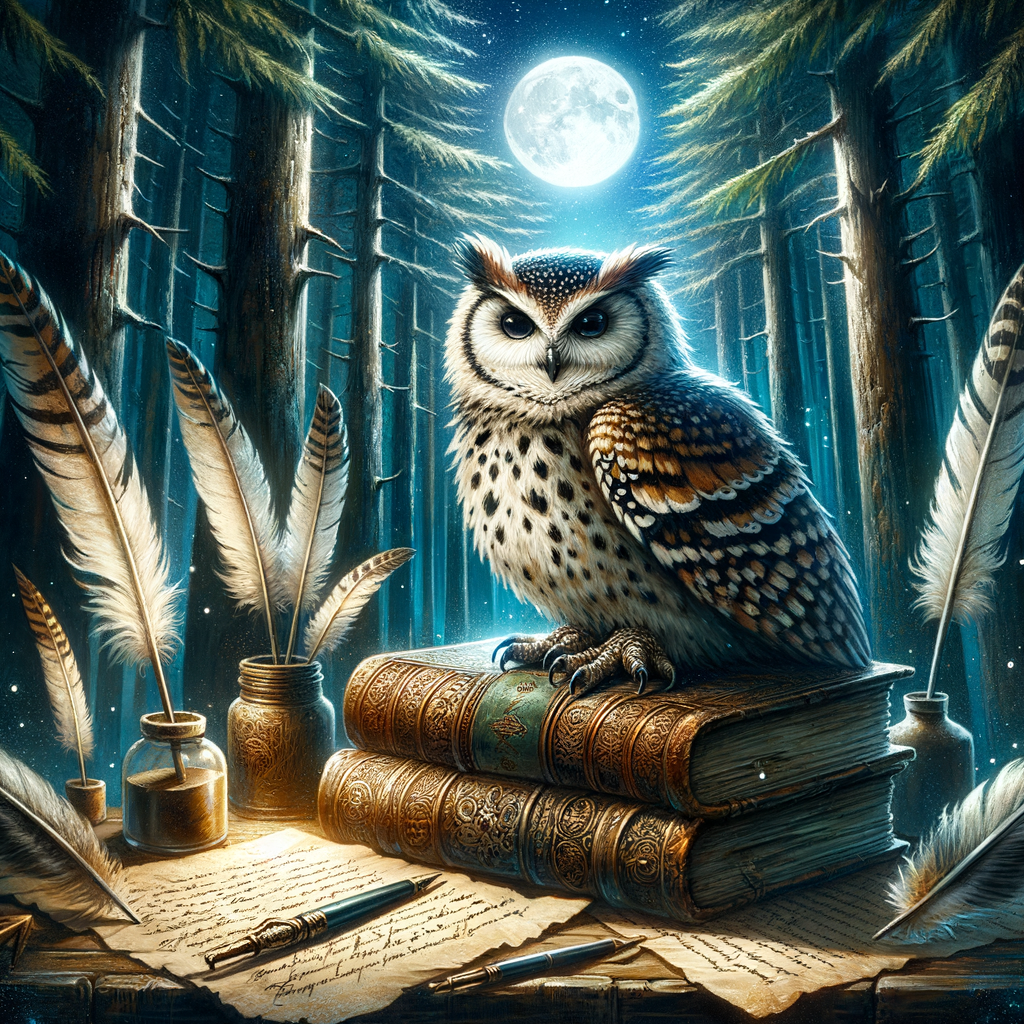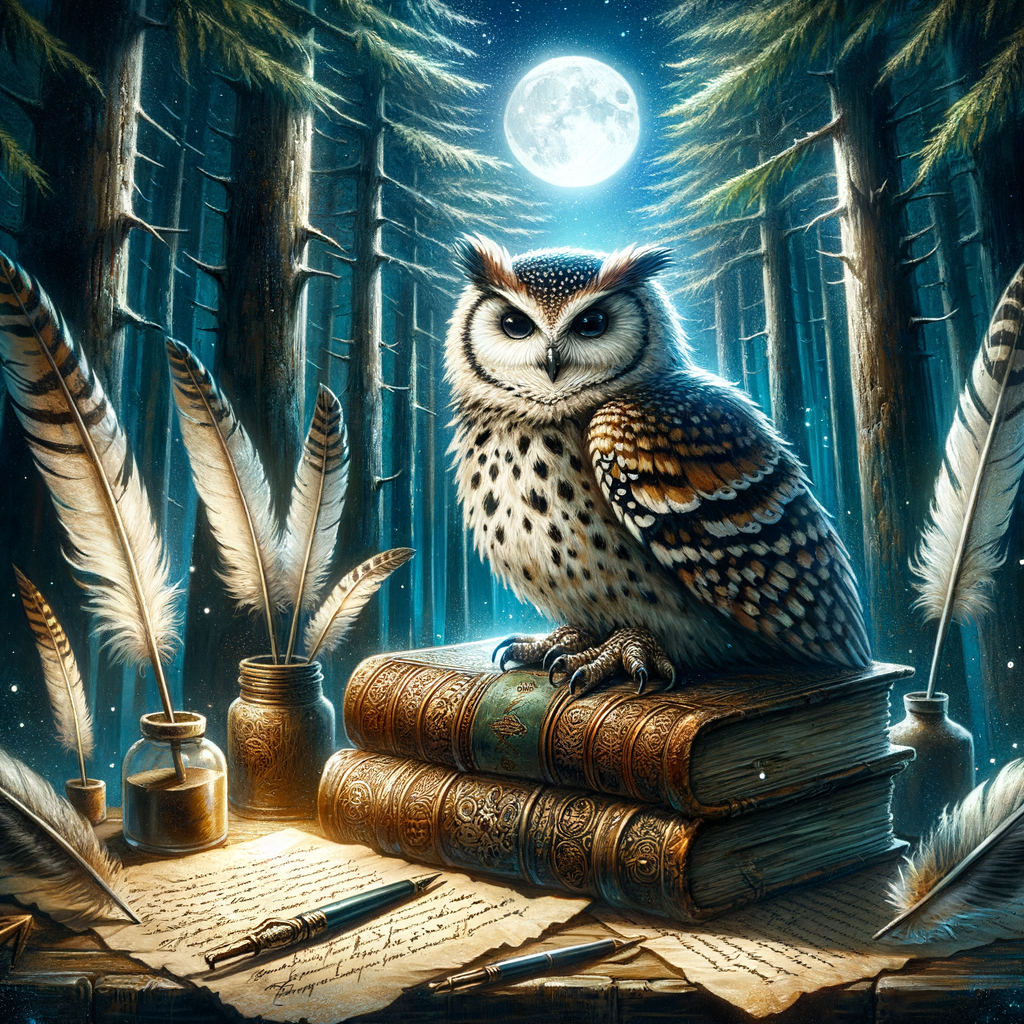
Introduction to Owls in Literature
-
- Overview of the Prevalence of Owls in Literature
Owls have been a common figure in literature for many years. They appear in stories, poems, and myths from different cultures. These birds are often used to symbolize wisdom, mystery, and even magic. For example, in the Harry Potter series, owls are used as magical messengers. This shows how owls can play important roles in stories.
-
- Historical Context of Owls in Literature
Owls have a rich history in literature. In ancient Greece, the owl was a symbol of Athena, the goddess of wisdom. This made the owl a sign of knowledge and learning. In medieval Europe, owls were sometimes seen as bad omens. They were thought to bring bad luck or death. Despite this, many writers used owls to add depth and meaning to their stories.
Owl Symbolism in Poetry
General Symbolism of Owls
- Common themes associated with owls:Owls often symbolize wisdom and knowledge. They are seen as wise creatures because they can see in the dark, which represents seeing through deception or understanding hidden truths.
- Symbolic meanings of owls in different cultures:In Greek mythology, the owl is linked to Athena, the goddess of wisdom. In Native American cultures, owls can be seen as protectors or omens. In some Asian cultures, owls are believed to bring good luck and prosperity.
Specific Examples of Owl Symbolism in Poetry
-
Analysis of Owl Symbolism in Famous Owl Poems
For example, in William Shakespeare’s Macbeth, the owl’s cry is a sign of death. This shows how owls can symbolize bad omens.
Another famous poem is The Owl by Edward Thomas. Here, the owl represents loneliness and the feeling of being an outsider. The poem uses the owl’s hoot to create a sense of isolation.
In The Owl and the Pussycat by Edward Lear, the owl is a symbol of wisdom and adventure. This poem shows a different side of owl symbolism, focusing on the positive traits of the bird.
-
Comparison of Owl Symbolism Across Different Poetic Eras
Owl symbolism has changed over time. In ancient poems, owls were often seen as messengers of the gods. For example, in Greek mythology, the owl is linked to Athena, the goddess of wisdom.
During the Romantic era, poets like John Keats used owls to symbolize mystery and the unknown. In his poem Ode to a Nightingale, the owl’s presence adds a sense of wonder and magic.
In modern poetry, owls often symbolize deeper emotions like fear and loneliness. For example, in Sylvia Plath’s poem The Moon and the Yew Tree, the owl’s cry is a haunting sound that reflects the poet’s inner turmoil.
Poetic Era Owl Symbolism Ancient Messengers of the gods Romantic Mystery and the unknown Modern Fear and loneliness
Poetic Representations of Owls
- Owls in Classic Poetry
-
Case study: Owls in Shakespeare’s works
-
William Shakespeare often used owls in his plays and poems. For example, in Macbeth, the owl’s cry is a sign of doom. This bird is called the “fatal bellman” because its hoot is like a death knell. Owls in Shakespeare’s works symbolize bad omens and dark times.
-
-
Case study: Owls in Romantic poetry
-
Romantic poets like John Keats and William Wordsworth also wrote about owls. In Keats’ poem Ode to a Nightingale, the owl is a symbol of mystery and wisdom. Wordsworth, in his poem There Was a Boy, describes the owl’s call as a haunting and beautiful sound. These poets saw owls as symbols of nature’s beauty and mystery.
| Poet | Work | Owl Symbolism |
|---|---|---|
| William Shakespeare | Macbeth | Bad omens, doom |
| John Keats | Ode to a Nightingale | Mystery, wisdom |
| William Wordsworth | There Was a Boy | Nature’s beauty, haunting sound |
Owls in Modern Poetry
-
Analysis of the Evolution of Owl Imagery in Modern Poetry
This is different from older poems where owls were seen as omens. Today, poets use owls to explore themes like knowledge and the unknown.
For example, in “The Owl” by Edward Thomas, the owl’s call is a symbol of comfort and solitude. This contrasts with older views where owls were seen as scary.
Modern poets also use owls to talk about nature and the environment. They show how owls are important to the ecosystem. This helps readers think about protecting wildlife.
-
Comparison of Modern and Classic Representations of Owls
Aspect Classic Poetry Modern Poetry Symbolism Omens, death Wisdom, mystery Theme Fear, superstition Knowledge, nature Example Shakespeare’s Macbeth Edward Thomas’s The Owl Classic poems often show owls as bad omens. For example, in Shakespeare’s Macbeth, an owl’s cry means something bad will happen. In contrast, modern poems like Edward Thomas’s The Owl show owls as symbols of wisdom and peace.
Modern poets also focus more on the owl’s role in nature. They write about how owls help keep the balance in the ecosystem. This is different from classic poems that focus more on superstition.
Literary Analysis of Owls
-
Key takeaways from the analysis of owls in poetry:
- Owls are often seen as symbols of wisdom and knowledge.
- In many poems, owls represent mystery and the unknown.
- Some poets use owls to symbolize death or the afterlife.
- Owls can also signify solitude and quiet reflection.
-
Insights into the impact of owl symbolism on readers:
- Readers often feel a sense of awe and wonder when encountering owls in poetry.
- Owl imagery can evoke feelings of calmness and introspection.
- For some, owls may bring a sense of foreboding or eeriness.
- Overall, owls add depth and layers of meaning to poetic works.
Owl Imagery in Poems
Visual Imagery
- Analysis of the use of visual imagery in famous owl poems:Helps readers picture scenes in their minds. In many famous poems, owls are described in great detail. For example, in “The Owl” by Edward Thomas, the owl is depicted as a lonely, watchful creature. The poem uses words like “dark” and “silent” to create a vivid image of the owl in the night.
Another example is “The Owl and the Pussycat” by Edward Lear. Here, the owl is described with bright, colorful details. The poem talks about the owl’s “beautiful pea-green boat” and “elegant fowl.” These descriptions help readers see the owl as a charming and whimsical character.
- Impact of visual imagery on the interpretation of owl symbolism:Can change how we understand the symbolism of owls in poetry. When an owl is described with dark and mysterious imagery, it often symbolizes wisdom or mystery. For instance, in Shakespeare’s “Macbeth,” the owl’s appearance is linked to ominous events, adding to the play’s dark mood.
On the other hand, when owls are depicted with bright and cheerful imagery, they can symbolize joy or curiosity. In “The Owl and the Pussycat,” the playful description of the owl makes it a symbol of adventure and fun.
These different uses of visual imagery show how poets can shape our understanding of owls. By choosing specific words and details, poets guide us to see owls in various symbolic ways.
Auditory Imagery
-
Examination of the Use of Auditory Imagery in Owl Poetry
It helps readers “hear” the sounds described in the text. In owl poetry, auditory imagery often includes the hooting of owls, the rustling of leaves, and the quiet of the night.
For example, in the poem “The Owl” by Alfred Tennyson, the line “When cats run home and light is come, And dew is cold upon the ground, And the far-off stream is dumb,” uses auditory imagery to create a serene nighttime scene.
Such imagery helps readers feel like they are part of the scene, hearing the same sounds the poet describes. This makes the poem more engaging and vivid.
-
Role of Auditory Imagery in Enhancing Owl Symbolism
Plays a key role in enhancing owl symbolism in poetry. Owls are often associated with wisdom, mystery, and the night. The sounds they make, like hooting, add to this symbolism.
For example, the hoot of an owl can symbolize wisdom and knowledge. It can also create a sense of mystery and eeriness. This dual symbolism makes owls fascinating subjects in poetry.
In the poem “To the Owl” by John Keats, the line “Thou sing’st alone, sitting by the shore” uses the owl’s song to symbolize solitude and contemplation. This enhances the owl’s symbolic role as a wise and solitary figure.
Conclusion: The Enduring Symbolism of Owls in Literature
- Summary of the significance of owls in poetry:They often represent wisdom, mystery, and even death. Many poets use owls to convey deep emotions and complex ideas. For example, in Edgar Allan Poe’s poem “The Raven,” the bird symbolizes sorrow and loss.
- Reflection on the enduring appeal of owl symbolism in literature:Owls are fascinating creatures with their nocturnal habits and silent flight. They captivate our imagination and curiosity. This makes them perfect symbols for themes like knowledge, mystery, and transformation. Writers and poets continue to use owls to add depth and meaning to their works.
| Aspect | Details |
|---|---|
| Wisdom | Owls are often seen as wise creatures, representing knowledge and insight. |
| Mystery | Their nocturnal nature and silent flight add an element of mystery. |
| Transformation | Owls can symbolize change and transformation, reflecting their ability to see in the dark. |
The symbolism of owls in literature is rich and varied. They continue to inspire writers and poets, making them a powerful literary symbol.






